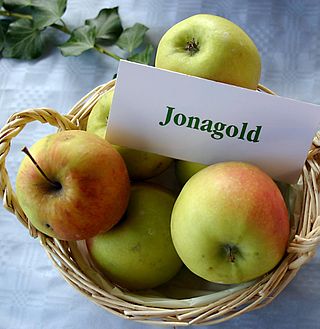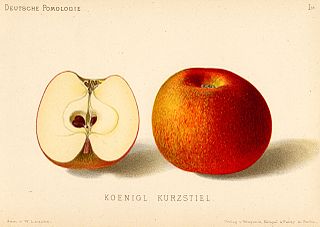
Cox's Orange Pippin, in Britain often referred to simply as Cox, is an apple cultivar first grown in 1825, at Colnbrook in Buckinghamshire, England, by the retired brewer and horticulturist Richard Cox.

Jonagold is a cultivar of apple that is a cross between the crisp Golden Delicious and the blush-crimson Jonathan; the name Jonagold is a portmanteau of these two variety names. It was developed in 1943 in New York State Agricultural Experiment Station of Cornell University's College of Agriculture and Life Sciences, selected as N.Y. 43013-1 in 1953, officially released in 1968 by Roger Way.

Gala is an apple cultivar with a sweet, mild flavour, a crisp but not hard texture, and a striped or mottled orange or reddish appearance. Originating from New Zealand in the 1930s, similar to most named apples, it is clonally propagated. In 2018, it surpassed Red Delicious as the apple cultivar with the highest production in the United States, according to the US Apple Association. It was the first time in over 50 years that any cultivar was produced more than Red Delicious.

The Elstar apple is an apple cultivar that was first developed in the Netherlands in Elst in the 1950s by crossing Golden Delicious and Ingrid Marie apples. It quickly became popular, especially in Europe and was first introduced to America in 1972. It remains popular in Continental Europe, but less so in the United Kingdom.

An apple is a round, edible fruit produced by an apple tree. Apple trees are cultivated worldwide and are the most widely grown species in the genus Malus. The tree originated in Central Asia, where its wild ancestor, Malus sieversii, is still found. Apples have been grown for thousands of years in Eurasia and were introduced to North America by European colonists. Apples have religious and mythological significance in many cultures, including Norse, Greek, and European Christian tradition.

Civni is an apple cultivar marketed as the Rubens apple. The Civni apple is a bicolored apple. It was first developed in 1985 as a cross of 'Gala' and 'Elstar' apples by the Consorzio Italiano Vivaisti (CIV), an Italian apple growers' consortium from Ferrara. They were granted a patent on the 'Civni' variety in 2003.

A 'Stayman' is a triploid apple cultivar developed in 1866 by Joseph Stayman of Leavenworth County, Kansas; it was sold by nurseries from 1895. 'Stayman' apples remain a locally popular cultivar of apples where grown.

The 'Laxton's Superb' is an apple cultivar that was developed in England in 1897. It is a cross breed between Cellini and 'Cox's Orange Pippin' and is not a cross between Wyken Pippin and Cox Orange Pippin. It is a British apple with a green color and a dull red flush. It is a firm-textured dessert apple. The fruit is well known for its sweet and aromatic taste which is likened to the parent species it is derived from, the 'Cox's Orange Pippin'.

White Transparent is an early-season cultivar of apple which is usually used for cooking due to its sharp taste. It is sometimes said to be the same as 'Yellow Transparent', but 'Yellow Transparent' is sometimes described differently, with fine rather than coarse flesh, and a sub-acid rather than acid flavour. Weight 75 g,

'Creston' is an apple cultivar released by the Pacific Agri-Food Research Centre at Summerland, British Columbia.

Rajka is a hybrid cultivar of domesticated apple from Czechia, specifically for eating. It was crossed and developed by the Institute of Experimental Botany from the Champion and Katka apples for scab resistance and is possible to grow according to organic standards.

Annurca, pronounced in Italy, also called Anurka, is a historically old cultivar of domesticated apple native to Southern Italy. It is believed to be the one mentioned by Pliny the Elder in his Naturalis Historia, and in the 16th century by Gian Battista della Porta. However it was first mentioned by this name by Giuseppe Antonio Pasquale.

'Ellison's Orange' is an English cultivar of domesticated apple, it is a cross between the 'Cox's Orange Pippin' and 'Cellini', which it resembles most in looks and taste, but can develop a distinct aniseed flavor in storage. The variety is much more disease-resistant than Cox's and therefore easier to cultivate.

Golden Russet is an old American cultivar of domesticated apple which is excellent for fresh eating as well as for apple cider production. It is a russet apple and is therefore especially used as a cider apple. It is sometimes known as 'English Golden Russet', and has frequently been confused with 'English Russet'.

Dorsett Golden is a 'Golden Delicious'-like cultivar of domesticated apple and is descended from it, but is different with that it is early season, and most importantly, it needs a lower amount of cold weather to go into blooming, so it is possible to grow in warm climates.

Court Pendu Plat is an extremely old French cultivar of domesticated apple that was first recorded in 1613. The cultivar definitely dates back to earlier than the 17th century, and was probably cultivated by the Romans. It is known for its intense flavor which mellows with storage.

Red Astrachan is a cultivar of domesticated apple of either Russian or Swedish origin, which is an early season apple, juicy, tart and mealy texture with pleasant flavour, and use for eating, cooking and cider. It is medium-sized, crimson colored. As all the early season apples, it is not good for storage. It is known by several other names including 'Abe Lincoln', 'American Red', and 'Waterloo'.

'Crimson Gold' is a modern cultivar of applecrab, meaning that it is a cross between a crabapple and a domesticated apple. It is a small apple.
Wyken Pippin is an old cultivar of domesticated apple originating in the Netherlands, or have originated in the garden of the Wyken Manor house in England from a seedling that was sourcing back to the Netherlands or Belgium, possibly in the early 1700s. It has several other names including 'Alford Prize' and 'Pheasant's Eye'.

Lady Alice is a cultivar of domesticated apple that was discovered in 1979 at an orchard near Gleed, Washington, as a chance seedling, and is a registered trademark by the Rainier Fruit Company. It is named after Alice Zirkle, a co-founder of the company.



















